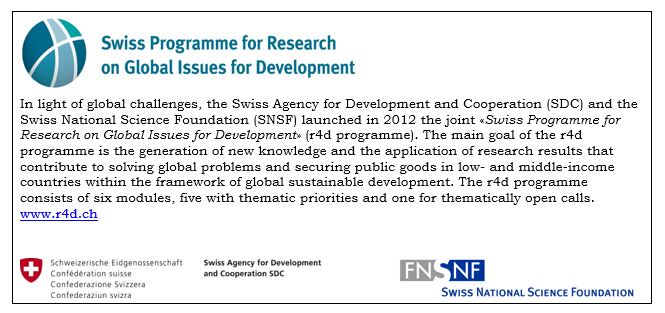The Project
Childpage navigation
Linking Education and Labour Markets: Under what conditions can Technical Vocational Education and Training (TVET) improve the income of the youth? (LELAM-TVET4INCOME)
Start of project: 01.06.2017
Financing: This project is financed by the Swiss Agency for Development and Cooperation (SDC) and the Swiss National Science Foundation (SNSF) under their joint "Swiss Programme for Research on Global Issues for Development" (external page r4d programme).
Duration: 36 months (can be extended to 72 months after successful mid-term evaluation)
The youth labour-market situation represents an important challenge for policy makers around the world. While a poor youth-labour market situation (for example due to high youth unemployment, bad working conditions and underemployment) poses immediate economic, political and social challenges, it also hampers the long-term growth of countries—especially if they fail to invest in the human capital of their youth. The negative consequences of a poor youth-labour market situation are especially relevant in low- and middle-income countries, where youth represent about one third of the population and often suffer from underemployment, low job quality and low income.
Technical vocational education and training (TVET), which prepares students for labour-market entry, is often regarded as a panacea for the problem of youth joblessness. However, little evidence exists to help policy makers increase the effectiveness of TVET by improving the regulative, normative and cultural-cognitive pillars of its social institutions.
This project aims to understand how policy makers in low- and middle-income countries can improve the youth labour-market situation by strengthening social institutions and their interdependence with formal, non-formal and informal TVET. This represents a crucial dimension of the TVET system, as these social institutions govern the involved actors, their roles, and their relationships with each other. Hence, this project aims to analyse the conditions under which TVET improves gainful employment and job quality and thereby improves the income of youth.
Q1: How can we define and measure social institutions of TVET?
Q2: How can we measure the youth labor market situation in low and middle income countries?
Q3: Does improving the linkage between the actors of the education and employment system reduce unemployment, improve gainful employment, job quality, and thus income of the youth?
Q4: How can the implementation and continuation of systemic changes in TVET be enhanced?
As there is still little evidence for how policy makers can increase the effectiveness of TVET by improving a country’s social institutions, this study aims to overcome this lack. In this way— and by incorporating knowledge-transfer activities with TVET, policy makers and the wider stakeholder communities in the partner countries— this study aims to influence new policies and the adaptation of ongoing reforms.
In the course of the project, we develop a conceptual framework concerning the composition and interdependence of social institutions in formal, non-formal and informal TVET. In particular, we focus on education-employment linkage, which is the institutionalized and observable communication of actors from the education and employment systems. Based on the insights of a document analysis and qualitative expert surveys, we conduct a structured education-employment linkage survey which results in a SWOT analysis of the linkage concept in the four case-study countries.
We apply the theoretical and empirical framework to the four case-study countries: Nepal, Benin, Costa Rica and Chile. These four countries differ substantially with respect to economic development and culture. We use this variation and exploit experimental and quasi-experimental variation created by past and upcoming TVET reforms and pilot projects to analyse the impact of the education-employment linkage on the youth labour-market situation. In this way, we cooperate closely with TVET policy makers, reform leaders and stakeholders by inviting them to participate in the CEMETS Institute of the Chair of Education Systems, which brings together reform leaders from all over the world, offering them research-based assistance with their reform cases.
The problem-based learning approach provides these policy makers, reform leaders and stakeholders with the opportunity to learn from reform challenges in other countries and to reflect critically on their reform plans with the feedback of an international peer group. Following these reforms as they progress allows us to analyse enabling factors and barriers to successful reform implementation and continuation, thereby bridging the gap between evidence, intentions and actions.
Furthermore, to help build the capacity to understand and govern a TVET system, this project aims to develop a TVET management master based in Nepal.
Grantees:
- Prof. Dr. Ursula Renold, Chair of Education Systems at D-MTEC, ETH Zurich, Switzerland
- Prof. Dr. Isabel Günther, NADEL Center for Development and Cooperation, ETH Zurich, Switzerland
- Prof. Dr. Mahesh Nath Parajuli, School of Education, Kathmandu University, Nepal
- Prof. Dr. Esaїe Gandonou, Department of Agricultural Economics and Extension, University of Abomey-Calavi, Republic of Benin
- Prof. Dr. Jacqueline García Fallas, Department of Education, University of Costa Rica, Costa Rica
- Prof. Dr. Paola Monserrat Bordón Tapia, School of Economics and Business, ILADES - Alberto Hurtado University, Chile
Partnerships outside the project consortium:
Stakeholder networks in each of the case study countries Nepal, Benin, Chile and Costa Rica will be established.
